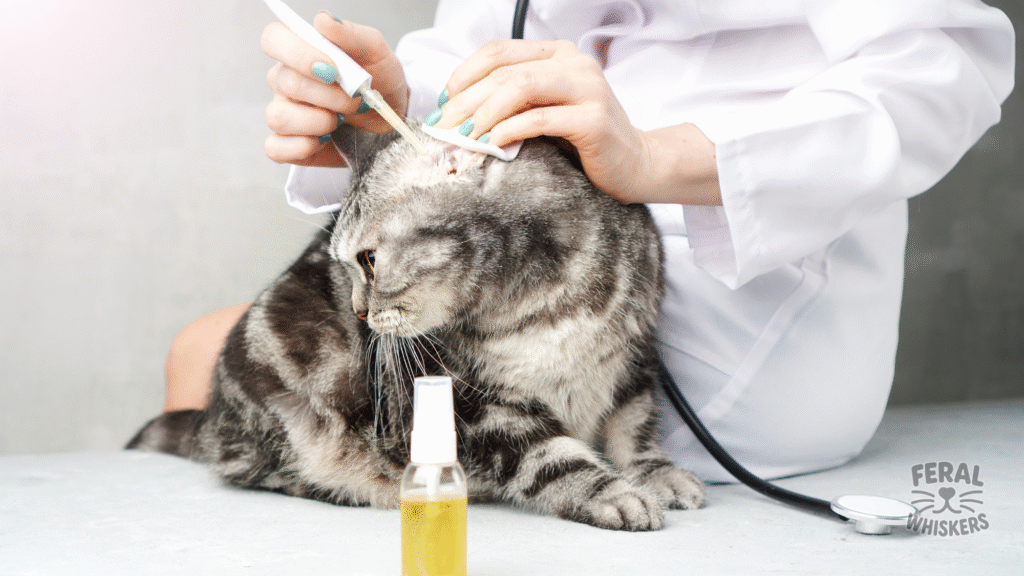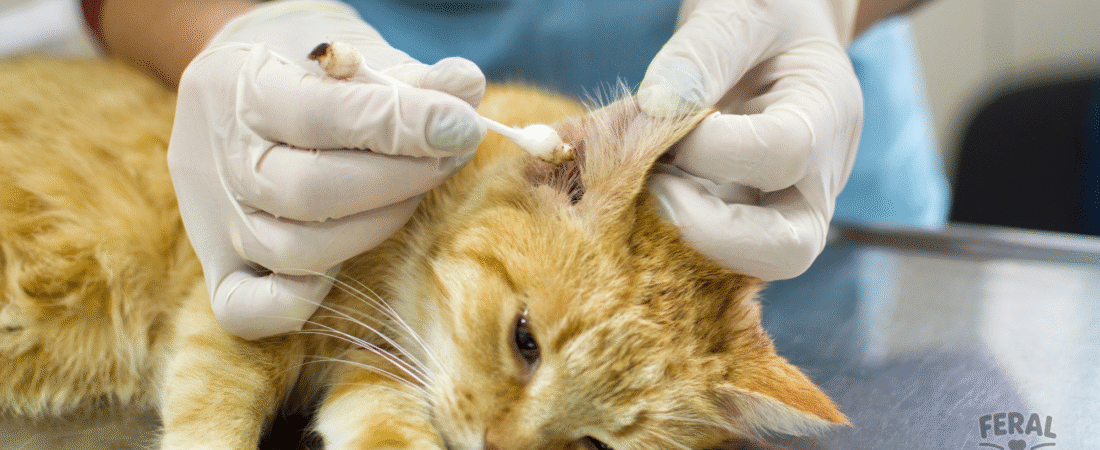📌 What Are Ear Mites?

Ear mites are microscopic external parasites that live in a cat’s ear canal. The most common species in cats is Otodectes cynotis.
- They feed on skin debris, ear wax, and natural oils inside the ear.
- Their constant movement and feeding trigger itching, inflammation, and irritation.
- Ear mites reproduce quickly: females lay eggs in the ear canal → eggs hatch into larvae in 4 days → mature to adults in about 3 weeks → cycling infestations unless treated.
- They are highly contagious between cats, dogs, and ferrets.
👉 While they rarely infest humans, people may develop itchy red rashes after contact with an affected cat.
🦠 How Do Cats Get Ear Mites?
Cats pick up these parasites mainly through direct or environmental exposure:
- Contact with infected animals: Grooming, playing, or sharing beds with another affected cat or dog easily transmits mites.
- Contaminated environment: Bedding, blankets, toys, and grooming tools can harbor mites temporarily.
- Multi-cat households: If one cat has mites, others usually do too — even if they show no symptoms at first.
- Outdoor exposure: Outdoor or stray cats carry and spread mites rapidly, sometimes infecting entire feline colonies.
💡 Indoor-only cats are still at risk if new pets, fosters, or rescue animals enter the home without being screened.
🚨 Why Ear Mites Are Dangerous
While ear mites are not usually fatal, they cause severe suffering if untreated.
- Intense itching → cats scratch so hard they cause bleeding, scabs, and hair loss around ears, face, and neck.
- Ear damage: Repeated trauma can rupture the eardrum or permanently thicken ear canals, leading to hearing loss.
- Secondary infections: Scratches open the door for bacterial or yeast infections that make symptoms worse.
- Spread to skin/other animals: Severe infestations may spread to the body, causing mange-like symptoms and infecting housemates.
👉 Left untreated, ear mites can turn into chronic ear disease requiring lifelong management.
🕵️ Symptoms of Ear Mites in Cats
Here’s what cat parents usually notice:
- Head shaking: Cats whip their heads constantly trying to remove mites.
- Persistent scratching: Nails against ears or rubbing face against furniture/carpets.
- Thick, crumbly black discharge in ears: This looks like coffee grounds. It’s a mix of dried blood, wax, and mite debris.
- Red, scabby ears: Ear canals look raw, swollen, and irritated.
- Restlessness/irritability: The constant itch makes affected cats cranky.
- Secondary wounds: Sores and scratches around the ears, neck, and cheeks.
- Strong ear odor: Due to debris + possible infection.
💡 Important: Black ear wax is not always mites. Sometimes bacterial or yeast infections look similar. That’s why a vet diagnosis is critical before starting treatment.
🔍 Diagnosis
- Otoscope exam: Vets insert a scope into the ear canal to visually spot mites moving around.
- Microscope slide: A sample of black debris is examined; mites and eggs appear as moving white specks.
- Differential diagnosis: A vet determines if it’s mites, yeast, or bacteria since treatments differ.
👉 Many cat parents assume “black ear wax = mites,” but misdiagnosis is a common mistake. Incorrect home treatments can make real infections worse.
🩺 Veterinary Treatments for Ear Mites
Modern vet medications are quick, safe, and effective:

- Ear Drops (direct application):
- Ivermectin-based (eliminates mites directly in ears).
- Milbemycin formulations.
- Usually used daily for several weeks to kill all mite life stages.
- Spot-On Parasite Preventives (back-of-neck treatments):
- Revolution® (Selamectin): Treats ear mites, fleas, ticks, and heartworm.
- Advocate®/Advantage Multi® (Moxidectin + Imidacloprid): Broad-spectrum parasite prevention.
- Bravecto® (Fluralaner): Long-lasting tick/flea control that also eliminates ear mites.
- Secondary treatments:
- Antibiotics if bacterial infection present.
- Antifungal drops if yeast overgrowth occurred.
- Anti-inflammatory meds for severe pain/irritation.
👉 All pets in household must be treated to avoid reinfection.
🌿 Holistic & Natural Supports
While vet meds kill mites, holistic options help soothe ears and prevent recurrence:
- Coconut oil: Naturally antimicrobial and soothing. A few drops can reduce swelling and itching.
- Aloe vera (100% pure): Calms inflamed ears. Use sparingly and only around skin, not deep inside canal.
- Olive or mineral oil flushes: Smother mites temporarily and loosen debris, though not a cure — supportive only.
- Apple cider vinegar (diluted): Can be used externally to wipe ear flap, but not poured inside the canal.
⚠️ Cats have extremely delicate ears: Avoid harsh oils, garlic “home cures,” or essential oils (toxic to felines).
🏡 Environmental Control
Mites don’t live long off the host, but environmental cleaning helps prevent reinfection:
- Wash all bedding and blankets in hot water.
- Vacuum carpets and soft furnishings.
- Clean carriers, toys, and grooming tools with hot soapy water.
- Treat dogs or other household pets simultaneously.
🛡️ Prevention
- Monthly parasite prevention (e.g., Revolution, Advantage Multi) protects against mites as well as fleas/ticks.
- Routine ear checks: Look for dark wax, redness, or odor once a month.
- New pet quarantine: Rescue cats/new additions should be vet-checked before mixing with other pets.
- Indoor lifestyle: Limits exposure to stray carriers.
❓ FAQs
Q1: Will mites go away if untreated?
No. They breed continuously until treated, and symptoms worsen over time.
Q2: Can I just clean my cat’s ears to get rid of mites?
Cleaning may reduce debris/itch, but it doesn’t kill mites. Medication is needed to eliminate them.
Q3: Can humans catch cat ear mites?
They rarely infest humans long-term, but may cause temporary itchy welts.
Q4: What’s the difference between mites and yeast infections?
Mites = coffee-ground black debris, extreme itching.
Yeast = brown goopy discharge, strong odor. A vet exam distinguishes them.
💡 Final Thoughts
Ear mites are incredibly small, but the suffering they cause cats is immense.
✅ Successful management requires:
- Veterinary treatment to kill mites.
- Holistic care for comfort, healing, and immune support.
- Environmental cleaning & treating all pets to prevent reinfection.
Key takeaway: Ear mites are easily treatable with a vet plan, but if ignored, they can lead to permanent damage and secondary infections.

